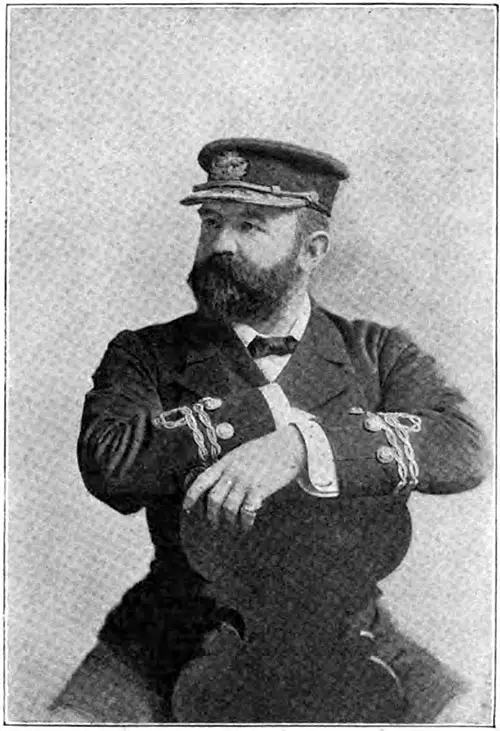Captain John D. Cameron

White Star Line Captain John D. Cameron circa 1897. GGA Image ID # 12f00142a7
Captain John D. Cameron is another good type of the ocean-ferry commanders. He set out on his salt-water career as a midshipman apprentice on the Black Ball Line, his early experience being in sailing vessels, the best “primary school for thorough seamanship,” in Captain Randle's view.
In that, most masters of ships agree with him. From the Black Ball Line, Captain Cameron went into the White Star service. That was twenty-nine years ago. He has been in that service ever since, though not always in the Atlantic boats.
He began in the company's sailing ships as first officer, and for four years was on the West Coast of South America.
“Indeed, I have been in all the companies' services,” he said, “and in all parts of the globe. I used to go around the world every four months. That was in the Australian trade — out by the Cape of Good Hope and round by the Horn back again–calling at Tenerife, Cape Town, Hobart, and New Zealand, and at Tenerife and Plymouth on the return voyage to London.
For the last eleven years I have been in the Atlantic service”; and it may be added that, as master of the Teutonic, Captain Cameron is one of the most popular commanders “on the beat.”
He confesses that the life suits him, and in truth it does not seem to have hurt him one half as much as the anxious life on shore hurts the stay-at-home landsman; and that, notwithstanding the fact that before now he has had to be on deck forty-eight hours at a stretch.
That was during a fog— “a most anxious time, especially about the Newfoundland Banks, where there are so many fishermen, or when you have to feel your way along the coast with the lead.”
“The career is full of life and incident,” says Captain Cameron. “There is always something going forward on board to keep people on the qui vive, even if it is only noting the progress of the ship, and the excitement becomes intense if there is a chance of making a record passage.”
Captain Cameron's best record in the Teutonic is 5 days 16 hours and 38 minutes.
On one occasion the excitement was varied by watching the rescue of a passenger, who had jumped overboard, and the gallant third officer taking a header after him. Another time nine men were rescued from a wreck.
This, however, was in a terrific blizzard, when nearly all the passengers were below—“the worst blizzard I ever experienced,” says Captain Cameron.
“We put out a boat to fetch then off, but it was four degrees below zero, and our men got so frost-bitten that they could not go on. So we took them in, and I backed up to the wreck. They then put one of their boats out, and we hauled them onboard.”
Captain Cameron explains that “they" are the crew of the American schooner Josie Reeves, and that for the rescue, which took place off the American coast, he received a watch from the President of the United States.
Capt. John D. Cameron, of the White Star liner Oceanic, will probably not make more than one additional trip to this country. The International Mercantile Marine Co. have appointed him their general superintendent for the new mid-weekly Atlantic service from Southampton, and to act in the same capacity for the American line at that port. They have also appointed to the position of superintendent engineer of the same service at Southampton Mr. F. J. Blake, R. N. R.
Capt. Cameron is exceedingly well known in the Atlantic passenger trade. He is a Liverpool man, and was born in that city in 1851. He was educated at the Liverpool Institute, and served his apprenticeship with Messrs. H. Fernie & Sons, of that port. Leaving that firm he spent some years as an officer on the sailing ships of Messrs. Ismay, Imrie & Co.
He joined the White Star line as fourth officer in 1877, and in less than seven years he secured the position of commander. He has had charge of most of the principal ships in the White Star line and was appointed to the command of the Oceanic when she was launched in 1899 and has held that position up to the present time.
It was while commanding the Teutonic in 189s. that the gallant skipper brought his vessel through the terrific blizzard and saved the lives of eleven men on the sinking fishing schooner Josie Reeves. Arriving off Sandy Hook he found the blizzard raging and decided it was too hazardous to attempt port. Putting to sea he fell in with the fishing vessel, which was rapidly sinking.
Capt. Cameron ordered boats lowered from the Teutonic to take off the imperiled crew, but so fearful was the storm that the rescuers could not reach the schooner. Capt. Cameron kept maneuvering his ship until it sheltered the boats long enough for them to make their way to the sinking fishing boats and take of the imperiled men. For this service, the captain received an appropriately engraved watch from the Life Saving Service, and each of the rescuers received a medal.
